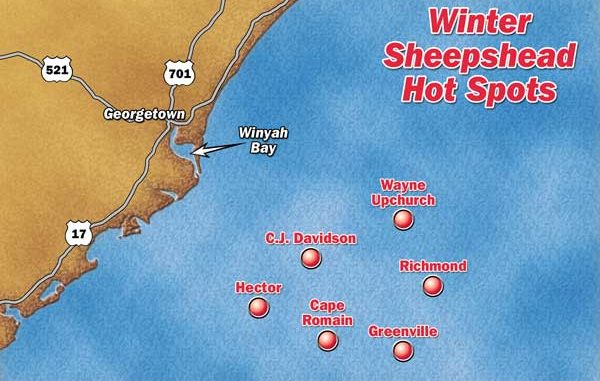
March is prime time to put a herd in your cooler in the nearshore waters off Georgetown.
As the seasons change, avid sportsman are confronted with challenges as they try to divide up their precious time in the outdoors.
It’s sometimes tough to decide, especially in spring and fall when there are so many choices — including hunting — but at the tail end of winter, March offers one great choice — to put the smackdown on a heavy stringer of over-sized, striped bandits within sight of shore.
Also known as “convicts of the sea” for their infamous bait-stealing nature and prison-style coloration, sheepshead are vulnerable to a fisherman trained in winter tactics.
Sheepshead may not win any beauty contests, but they will earn a blue ribbon every time with their tasty white flesh and amazing fighting strength.
When March winds bring warm air into the region, the water temperature lags far behind, especially in South Carolina’s inshore waters. When the temperature drops in late fall, sheeps-head will abandon their usual hangouts and venture into the warmer ocean waters, stopping near submerged structure to spawn during late winter and early spring.
A sheepshead’s egg and larval stages require the full salinity of ocean water to survive, so the adults stay through the spawn, congregating and suspended over or adjacent to nearshore and offshore reefs.
Nowhere is this more true than off Georgetown and Winyah Bay.
“The jetties at Georgetown are covered with trophy sheepshead during most of the year, with the exception of the spawning period from late winter through early spring,” said Capt. Steve Hedrick of ReelEZ Guide Service. “Georgetown sheepshead gather at the C.J. Davidson, Richmond, and Greenville (reefs and wrecks) fairly heavily, but can be found at almost every reef out there in water greater than 25 feet deep.
Hedrick (843-344-FISH), who has been catching sheepshead for better than 30 years, fishes out of Belle Isle Marina and knows how to catch them year-round.
As long as water temperatures are fairly stable, Sheepshead will suspend in schools over reefs. Hedrick shortens his search time by using his bottom machine (depthfinder) to identify suspended fish. Many wrecks and artificial reefs have material scattered over a large area, and the bottom machine allows fishermen to find the structure and schools of fish suspending above it.
Hedrick recommends keeping in touch with local scuba divers who frequent the many nearshore reefs, because they’ll usually remember running into a big school of big, striped fish.
After locating fish on his bottom machine, Hedrick finds a place where he can anchor up and fish vertically.
“The fish will generally be within 10 or 12 feet of the surface, but I start near the bottom and work my rig up the water column until I get a bite,” Hedrick said.
If sheepshead are present, biting is almost an afterthought. The February-to-April spawning season is generally overlooked as a hot angling period. The trip offshore and spawning activities quickly deplete the fishes’ energy reserves and leave them exceptionally hungry. While they eat a variety of foods — shrimp, crabs, algae, small fish, and barnacles — much of their preferred crustacean diet is harder to come by at their spawning locations.
Typically, sheepshead are known for their challenging bite, however, they become less finicky and will take a variety of different baits readily and aggressively during the spawning season at the reefs.
Hedrick gives them exactly what they crave, sushi-style: young barnacles and Asian green mussels wrapped in a green mat of algae. He finds these masses of crustaceans and algae caked on the jetty rocks and pilings around the mouth of Winyah Bay.
“While fiddler crabs (china back crabs) are good baits and usually the preferred bait among sheepshead anglers, the globs of young barnacles are ideal,” Hedrick said. “Almost every sheepshead I have ever cleaned has a belly full of barnacles and shells.
“Sheepshead will travel out of their way to gobble up a mouthful of the barnacle-algae mass. A lot of baits will work this time of year, but in my opinion, the barnacle globs are the best.”
Barnacles grow on any structure that’s either fully or partially-submerged in water that as a high salt content. Hedrick targets the smaller barnacles growing in the algal mat that covers the surface of the lower end of the structure. As an added bonus, some small Asian green mussels will be attached to the same green algal mats the barnacles.
The rock jetties lining the entrance to Winyah Bay are prime areas to gather bait. Hedrick likes to arrive at low tide and scrape the globs of barnacles/algal growth off the rocks using a putty knife and leather gloves. The smaller barnacles tend to have more algal growth on them and are easier to get on the hook.
Gathering bait, especially live bait, is always a grueling activity. Hedrick gathers and stockpiles barnacle masses and freezes them for later use. While fresh bait is almost always more productive, frozen barnacles tend to work almost as well as freshly gathered ones.
Tactics for catching sheepshead rarely deviate from the norm. It’s typical to bury a hook in their jaws, especially when using the typical china back fiddler crab as bait. The bait stealers will suck the crab off the hook, leaving the angler empty-handed.
On the other hand, sheepshead are more aggressive when they eat barnacles, giving fishermen a chance for a good hookset. However, getting barnacles on the hook and keeping them securely fastened can be another challenge. This is the prime reason for selecting the younger barnacles that are covered with the algal mat. Hedrick takes the globs of crustaceans and securely fastens the hook into the mess with a small rubber band.
Inshore wreck and reef fishing for sheepshead quickly tests the strength and abrasion resistance of an angler’s tackle. Summer hangouts are generally pylons, jetties, and other sharp objects troublesome for sheepshead angler’s gear.
According to Capt. Tommy Scarborough of Georgetown Coastal Adventures, the nature of wintertime sheepshead fishing “takes the rocks (per say) out of the equation.”
Scarborough downsizes his gear to get more bites, not worryng about losing fish from rubbing on submerged structure.
“Winter sheepshead do not hold tight to structure as they do inshore, but they will stay suspended above and on either the up-current or down-current side,” said Scarborough (843-546-3543 or www.captaintommy.com), who prefers using live shrimp or fiddlers because the bite will be more aggressive, with fish grabbing a bait and swimming off quickly.
“Sheepshead do not appear to be very choosy for food and will take most baits aggressively and usually quite fast,” he said.
Most of the sheepshead around reefs are of spawning age. The average fish is exceptionally large, often reaching double digits and sending any fishermen into overdrive during an over-the-bow battle.
Compared to redfish, sea trout, and king mackerel, the sheepshead gets little attention most of the year — especially when trophy fish school lurking above offshore reefs.

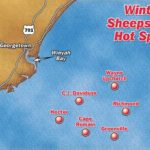
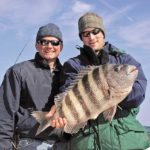
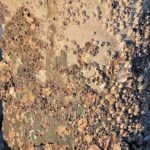
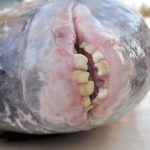
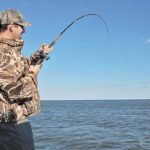



Be the first to comment